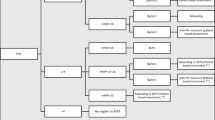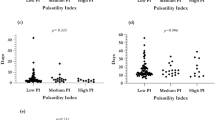Abstract
In individuals with a single ventricle undergoing evaluation before Fontan surgery, the presence of excessive pulmonary blood flow can contribute to increased pulmonary artery pressure, notably in those who had a Glenn procedure with antegrade pulmonary flow. 28 patients who had previously undergone Glenn anastomosis with antegrade pulmonary blood flow (APBF) and with elevated mean pulmonary artery (mPAP) pressure > 15 mmHg in diagnostic catheter angiography were included in the study. After addressing other anatomical factors that could affect pulmonary artery pressure, APBF was occluded with semi-compliant, Wedge or sizing balloons to measure pulmonary artery pressure accurately. 23 patients (82% of the cohort) advanced to Fontan completion. In this group, median mPAP dropped from 20.5 (IQR 19–22) mmHg to 13 (IQR 12–14) mmHg post-test (p < 0.001). Median PVR post-test was 1.8 (IQR 1.5–2.1) WU m2. SpO2 levels decreased from a median of 88% (IQR 86%–93%) pre-test to 80% (IQR 75%–84%) post-test (p < 0.001). In five patients, elevated mPAP post-test occlusion on diagnostic catheter angiography led to non-completion of Fontan circulation. In this group, median pre- and post-test mPAP were 23 mmHg (IQR 21.5–23.5) and 19 mmHg (IQR 18.5–20), respectively (p = 0.038). Median post-test PVR was 3.8 (IQR 3.6–4.5) WU m2. SpO2 levels decreased from a median of 79% (IQR 76%–81%) pre-test to 77% (IQR 73.5%-80%) post-test (p = 0.039). Our study presents a specialized approach for patients initially deemed unsuitable for Fontan due to elevated pulmonary artery pressures. We were able to successfully complete the Fontan procedure in the majority of these high-risk cases after temporary balloon occlusion test.


Similar content being viewed by others
References
Hosein RBM, Clarke AJB, McGuirk SP et al (2007) Factors influencing early and late outcome following the Fontan procedure in the current era. The “two commandments”? Eur J Cardiothorac Surg 31:344–353. https://doi.org/10.1016/j.ejcts.2006.11.043
d’Udekem Y, Xu MY, Galati JC et al (2012) Predictors of survival after single-ventricle palliation: the impact of right ventricular dominance. J Am Coll Cardiol 59:1178–1185. https://doi.org/10.1016/j.jacc.2011.11.049
Pascall E, Tulloh RM (2018) Pulmonary hypertension in congenital heart disease. Future Cardiol 14:343–353. https://doi.org/10.2217/fca-2017-0065
Egbe AC, Connolly HM, Miranda WR et al (2017) Hemodynamics of Fontan failure: the role of pulmonary vascular disease. Circ Heart Fail 10:e004515. https://doi.org/10.1161/CIRCHEARTFAILURE.117.004515
Giglia TM, Humpl T (2010) Preoperative pulmonary hemodynamics and assessment of operability: is there a pulmonary vascular resistance that precludes cardiac operation? Pediatr Crit Care Med 11:S57-69. https://doi.org/10.1097/PCC.0b013e3181d10cce
Hauck A, Porta N, Lestrud S, Berger S (2017) The pulmonary circulation in the single ventricle patient. Children 4:71. https://doi.org/10.3390/children4080071
Van De Bruaene A, Budts W (2023) Collaterals in congenital heart disease: when and how to treat? Cardiovasc Diagn Ther 13:418–426. https://doi.org/10.21037/cdt-23-10
Zhang T, Shi Y, Wu K et al (2016) uncontrolled antegrade pulmonary blood flow and delayed Fontan completion after the bidirectional Glenn procedure: real-world outcomes in China. Ann Thorac Surg 101:1530–1538. https://doi.org/10.1016/j.athoracsur.2015.10.071
Ganigara M, Prabhu A, Varghese R et al (2010) Extracardiac Fontan operation after late bidirectional Glenn shunt. Asian Cardiovasc Thorac Ann 18:253–259. https://doi.org/10.1177/0218492310367961
Yan T, Tong G, Zhang B et al (2018) The effect of antegrade pulmonary blood flow following a late bidirectional Glenn procedure. Interact Cardiovasc Thorac Surg 26:454–459. https://doi.org/10.1093/icvts/ivx325
Choussat A, Fontan F, Besse P (1978) Selection criteria for Fontan’s procedure. In: Anderson RH, Shinebourne EA (eds) Pediatric cardiology. Churchill Livingstone, Edinburgh, pp 559–566
Poh CL, Cordina RL, Iyengar AJ et al (2021) Pre- and Post-operative determinants of transplantation-free survival after Fontan. The Australia and New Zealand experience. IJC Heart Vasculature 35:100825. https://doi.org/10.1016/j.ijcha.2021.100825
Mohammad Nijres B, Murphy JJ, Diab K et al (2018) routine cardiac catheterization prior to Fontan operation: is it a necessity? Pediatr Cardiol 39:818–823. https://doi.org/10.1007/s00246-018-1825-8
Banka P, McElhinney DB, Bacha EA et al (2010) what is the clinical utility of routine cardiac catheterization before a Fontan operation? Pediatr Cardiol 31:977–985. https://doi.org/10.1007/s00246-010-9736-3
Beghetti M (2010) Fontan and the pulmonary circulation: a potential role for new pulmonary hypertension therapies. Heart 96:911–916. https://doi.org/10.1136/hrt.2010.193912
Kido T, Burri M, Mayr B et al (2021) Impacts of stage 1 palliation and pre-Glenn pulmonary artery pressure on long-term outcomes after Fontan operation. Eur J Cardiothorac Surg 60:369–376. https://doi.org/10.1093/ejcts/ezab079
Van Slooten YJ, Elzenga NJ, Waterbolk TW et al (2012) The effect of additional pulmonary blood flow on timing of the total cavopulmonary connection. Ann Thorac Surg 93:2028–2033. https://doi.org/10.1016/j.athoracsur.2012.02.053
Nichay NR, Gorbatykh YN, Kornilov IA et al (2017) Bidirectional cavopulmonary anastomosis with additional pulmonary blood flow: good or bad pre-Fontan strategy. Interact Cardiovasc Thorac Surg 24:582–589. https://doi.org/10.1093/icvts/ivw429
Schranz D (2021) Hemodynamics under general anesthesia in Glenn/Fontan circulation? Pediatr Cardiol 42:465–466. https://doi.org/10.1007/s00246-021-02559-4
Stumper O, Penford G (2017) Catheter hemodynamic assessment of the univentricular circulation. Ann Pediatr Cardiol 10:167–174. https://doi.org/10.4103/apc.APC_160_16
Özyüksel A, Şimşek B, Özden Ö et al (2021) Fontan procedure in patients with preoperative mean pulmonary artery pressure over 15 mmHg. J Card Surg 36:941–949. https://doi.org/10.1111/jocs.15293
Lemler MS, Scott WA, Leonard SR et al (2002) Fenestration improves clinical outcome of the Fontan procedure: a prospective, randomized study. Circulation 105:207–212. https://doi.org/10.1161/hc0202.102237
Snarr BS, Paridon SM, Rychik J, Goldberg DJ (2015) Pulmonary vasodilator therapy in the failing Fontan circulation: rationale and efficacy. Cardiol Young 25:1489–1492. https://doi.org/10.1017/S1047951115002309
Funding
This study was not funded by any internal or external funds.
Author information
Authors and Affiliations
Contributions
IHD, IKY, DMO, and AC: conceptualization; IHD, IKY, and AC: methodology; IHD, IKY, EHY, and OK: formal analysis and investigation; IHD, IKY, DMO, MS, OK, and MOB: writing—original draft preparation; IHD, MS, IKY, OK, and DMO: writing—review and editing; IKY, IHD, NAA, and AC: supervision.
Corresponding author
Ethics declarations
Conflict of interest
The authors declare that they have no conflict of interest.
Ethical Approval
This retrospective chart review study involving human participants was in accordance with the ethical standards of the institutional and the national research committee and with the 1964 Helsinki Declaration and its later amendments or comparable ethical standards.
Informed Consent
Written and informed consent were taken from the parents before the interventional procedures.
Additional information
Publisher's Note
Springer Nature remains neutral with regard to jurisdictional claims in published maps and institutional affiliations.
Rights and permissions
Springer Nature or its licensor (e.g. a society or other partner) holds exclusive rights to this article under a publishing agreement with the author(s) or other rightsholder(s); author self-archiving of the accepted manuscript version of this article is solely governed by the terms of such publishing agreement and applicable law.
About this article
Cite this article
Demir, I.H., Celebi, A., Ozdemir, D.M. et al. Utility of Balloon Occlusion Testing in Determining Fontan Suitability Among Patients with Elevated Pulmonary Artery Pressure and Additional Antegrade Pulmonary Blood Flow. Pediatr Cardiol 45, 632–639 (2024). https://doi.org/10.1007/s00246-023-03380-x
Received:
Accepted:
Published:
Issue Date:
DOI: https://doi.org/10.1007/s00246-023-03380-x




